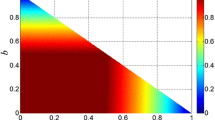Abstract
Information quality is widely used in many applications. However, how to measure information quality in basic probability assignment accurately is still an open issue. Generalized expression for information quality is an effective method to measure information quality in basic probability assignment. Nevertheless, the counter-intuitive results may be obtained when statements are of intersection. To address this issue, a new expression for information quality of basic probability assignment is proposed in this paper considering the frame of discernment and the influence of intersection among statements which can cause changes of uncertainty. Numerical examples are illustrated to demonstrate the effectiveness of the proposed method. In addition, an application in target recognition is used to show the validity of proposed form of information quality in combining conflicting evidences.


Similar content being viewed by others
Explore related subjects
Discover the latest articles, news and stories from top researchers in related subjects.References
Babajanyan S, Allahverdyan A, Cheong KH (2020) Energy and entropy: path from game theory to statistical mechanics. Phys Rev Res 2(4):043055
Benettin G, Galgani L, Strelcyn JM (1976) Kolmogorov entropy and numerical experiments. Phys Rev A 14(6):2338
Cao Z, Ding W, Wang YK, Hussain FK, Al-Jumaily A, Lin CT (2020) Effects of repetitive SSVEPs on EEG complexity using multiscale inherent fuzzy entropy. Neurocomputing 389:198–206
Dempster AP (1967) Upper and lower probabilities induced by a multi-valued mapping. Ann Math Stat 38(2):325–339
Deng Y (2020) Uncertainty measure in evidence theory. Sci China Inf Sci 63(11):1–19
Deng Y (2020) Information volume of mass function. Int J Comput Commun Control 15(6):3983
Deng J, Deng Y (2021) Information volume of fuzzy membership function. Int J Comput Commun Control 16(1):4106
Dvurečenskij A, Lachman D (2020) Spectral resolutions and observables in n-perfect MV-algebras. Soft Comput 24(2):843–860
Dvurečenskij A, Zahiri O (2019) States on EMV-algebras. Soft Comput 23(17):7513–7536
Fan L, Deng Y (2020) Determine the number of unknown targets in Open World based on Elbow method. IEEE Trans Fuzzy Syst. https://doi.org/10.1109/TFUZZ.2020.2966182
Fei L, Lu J, Feng Y (2020) An extended best-worst multi-criteria decision-making method by belief functions and its applications in hospital service evaluation. Comput Ind Eng 142:106355
Garrido P, Goldstein S, Lebowitz JL (2004) Boltzmann entropy for dense fluids not in local equilibrium. Phys Rev Lett 92(5):050602
Gini C, Pizetti E, Salvemini T (1912) Reprinted in Memorie di metodologica statistica. Rome: Libreria Eredi Virgilio Veschi 1
Jiang W, Cao Y, Deng X (2019) A novel Z-network model based on Bayesian network and Z-number. IEEE Trans Fuzzy Syst 28:1585–1599
Jousselme AL, Grenier D, Bossé Éloi (2001) A new distance between two bodies of evidence. Inf Fusion 2(2):91–101
Lai JW, Chang J, Ang LK, Cheong KH (2020) Multi-level information fusion to alleviate network congestion. Inf Fusion 63:248–255. https://doi.org/10.1016/j.inffus.2020.06.006
Lefevre E, Colot O, Vannoorenberghe P (2002) Belief function combination and conflict management. Inf Fusion 3(2):149–162
Li D, Deng Y (2019) A new correlation coefficient based on generalized information quality. IEEE Access 7:175411–175419
Li Y, Xiao F (2019) Aggregation of uncertainty data based on ordered weighting aggregation and generalized information quality. Int J Intell Syst 34:1653–1666
Li D, Gao X, Deng Y (2019) A generalized expression for information quality of basic probability assignment. IEEE Access 7:174734–174739
Li M, Huang S, De Bock J, De Cooman G, Pižurica A (2020) A robust dynamic classifier selection approach for hyperspectral images with imprecise label information. Sensors 20(18):5262
Li Y, Pelusi D, Deng Y (2020) Generate two-dimensional belief function based on an improved similarity measure of trapezoidal fuzzy numbers. Comput Appl Math 39(4):1–20
Li D, Deng Y, Cheong KH (2021) Multi-source basic probability assignment fusion based on information quality. Int J Intell Syst. https://doi.org/10.1002/int.22363
Liang S, Deng X, Jiang W (2019) Optimal data fusion based on information quality function. Appl Intell 49:3938–3946
Liao H, Ren Z, Fang R (2020) A Deng-entropy-based evidential reasoning approach for multi-expert multi-criterion decision-making with uncertainty. Int J Comput Intell Syst 13:1281–1294. https://doi.org/10.2991/ijcis.d.200814.001
Liu W (2006) Analyzing the degree of conflict among belief functions. Artif Intell 170(11):909–924
Liu Z, Zhang Z, Liu Y, Dezert J, Pan Q (2019) A new pattern classification improvement method with local quality matrix based on K-NN. Knowl Based Syst 164:336–347. https://doi.org/10.1016/j.knosys.2018.11.001
Liu F, Gao X, Zhao J, Deng Y (2019) Generalized belief entropy and its application in identifying conflict evidence. IEEE Access 7:126625–126633
Liu T, Li C, Wang C, Lai J, Cheong K (2020) A simple-FSDT-based isogeometric method for piezoelectric functionally graded plates. Mathematics 8:2177. https://doi.org/10.3390/math8122177
Liu Z, Liu Y, Dezert J, Cuzzolin F (2020) Evidence combination based on credal belief redistribution for pattern classification. IEEE Trans Fuzzy Syst 28(4):618–631. https://doi.org/10.1109/TFUZZ.2019.2911915
Liu Q, Cui H, Tian Y, Kang B (2020) On the Negation of discrete Z-numbers. Inf Sci 537:18–29
Luo Z, Deng Y (2020) A vector and geometry interpretation of basic probability assignment in Dempster–Shafer theory. Int J Intell Syst 35(6):944–962
Murphy CK (2000) Combining belief functions when evidence conflicts. Decis Support Syst 29(1):1–9
Pan Y, Zhang L, Wu X, Skibniewski MJ (2020) Multi-classifier information fusion in risk analysis. Inf Fusion 60:121–136
Rényi A, et al. (1961) On measures of entropy and information. In: Proceedings of the fourth berkeley symposium on mathematical statistics and probability, Volume 1: contributions to the theory of statistics, The Regents of the University of California
Ruan J, Wang Z, Chan F, Patnaik S, Tiwari M (2020) A reinforcement learning-based algorithm for the aircraft maintenance routing problem. Expert Syst Appl 169:114399. https://doi.org/10.1016/j.eswa.2020.114399
Shafer G (1976) A mathematical theory of evidence, vol 42. Princeton university press
Shannon CE (1948) A mathematical theory of communication. Bell Syst Tech J 27(3):379–423
Song X, Qin B, Xiao F (2020) FR–KDE: a hybrid fuzzy rule-based information fusion method with its application in biomedical classification. Int J Fuzzy Syst pp 1–13. https://doi.org/10.1007/s40815-020-00957-z
Tang SW, Zhou ZJ, Hu CH, Yang JB, Cao Y (2019) Perturbation analysis of evidential reasoning rule. IEEE Trans Syst Man Cybern Syst. https://doi.org/10.1109/TSMC.2019.2944640
Tao R, Liu Z, Cai R, Cheong KH (2021) A dynamic group MCDM model with intuitionistic fuzzy set: perspective of alternative queuing method. Inf Sci 555:85–103
Tian Y, Liu L, Mi X, Kang B (2020) ZSLF: a new soft likelihood function based on Z-numbers and its application in expert decision system. IEEE Trans Fuzzy Syst. https://doi.org/10.1109/TFUZZ.2020.2997328
Tsallis C (1988) Possible generalization of Boltzmann-Gibbs statistics. J Stat Phys 52(1–2):479–487
Tsallis C (2009) Nonadditive entropy: the concept and its use. Eur Phys J A 40(3):257
Wang C, Zhi-Xuan T, Ye Y, Wang L, Cheong K, Xie Ng (2017) A rumor spreading model based on information entropy. Sci Rep. https://doi.org/10.1038/s41598-017-09171-8
Wang T, Wei X, Huang T, Wang J, Valencia-Cabrera L, Fan Z, Pérez-Jiménez MJ (2019) Cascading failures analysis considering extreme virus propagation of cyber-physical systems in smart grids. Complexity. https://doi.org/10.1155/2019/7428458
Wang T, Wei X, Wang J, Huang T, Peng H, Song X, Cabrera LV, Perez-Jimenez MJ (2020a) A weighted corrective fuzzy reasoning spiking neural P system for fault diagnosis in power systems with variable topologies. Eng Appl Artif Intell 92:103680
Wang T, Liu W, Zhao J, Guo X, Terzija V (2020b) A rough set-based bio-inspired fault diagnosis method for electrical substations. Int J Electr Power Energy Syst 119:105961. https://doi.org/10.1016/j.ijepes.2020.105961
Wang H, Fang YP, Zio E (2021) Risk assessment of an electrical power system considering the influence of traffic congestion on a hypothetical scenario of electrified transportation system in New York state. IEEE Trans Intell Transp Syst 22(1):142–155. https://doi.org/10.1109/TITS.2019.2955359
Xiao F (2019) A distance measure for intuitionistic fuzzy sets and its application to pattern classification problems. IEEE Trans Syst Man Cybern Syst. https://doi.org/10.1109/TSMC.2019.2958635
Xiao F (2019) EFMCDM: evidential fuzzy multicriteria decision making based on belief entropy. IEEE Trans Fuzzy Syst 28:1477–1491
Xiao F (2020) A new divergence measure for belief functions in D-S evidence theory for multisensor data fusion. Inf Sci 514:462–483
Xue Y, Deng Y (2020) On the conjunction of possibility measures under intuitionistic evidence sets. J Ambient Intell Hum Comput. https://doi.org/10.1007/s12652-020-02508-8
Yager RR (1987) On the Dempster–Shafer framework and new combination rules. Inf Sci 41(2):93–137
Yager RR, Petry F (2016) An intelligent quality-based approach to fusing multi-source probabilistic information. Inf Fusion 31:127–136
Ye Y, Cheong K, Cen Y, Ng X (2016) Effects of behavioral patterns and network topology structures on parrondo’s paradox. Sci Rep 6:37028. https://doi.org/10.1038/srep37028
Ye Y, Hang XR, Koh JM, Miszczak JA, Cheong KH, Gang Xie N (2020) Passive network evolution promotes group welfare in complex networks. Chaos Solitons Fractals 130:109464. https://doi.org/10.1016/j.chaos.2019.109464
Yong D, WenKang S, ZhenFu Z, Qi L (2004) Combining belief functions based on distance of evidence. Decis Support Syst 38(3):489–493
Zadeh LA (1986) A simple view of the Dempster–Shafer theory of evidence and its implication for the rule of combination. Ai Mag 7(2):85–90
Zhang Z, Liu T, Chen D, Zhang W (2014) Novel algorithm for identifying and fusing conflicting data in wireless sensor networks. Sensors 14(6):9562–9581
Acknowledgements
The authors greatly appreciate meticulous suggestions of anonymous reviewers and the encouragement of editor. This research is supported by the Fundamental Research Funds for the Central Universities (No. SWU1909785) and Training Program of Innovation and Entrepreneurship for Undergraduates of Chongqing City (No. S202010635174).
Author information
Authors and Affiliations
Corresponding author
Ethics declarations
Conflict of interest
All the authors certify that there is no conflict of interest with any individual or organization for the present work. This article does not contain any studies with human participants or animals performed by any of the authors.
Additional information
Publisher's Note
Springer Nature remains neutral with regard to jurisdictional claims in published maps and institutional affiliations.
Rights and permissions
About this article
Cite this article
Li, H., Cai, R. An improved expression for information quality of basic probability assignment and its application in target recognition. Soft Comput 25, 6681–6690 (2021). https://doi.org/10.1007/s00500-021-05666-9
Accepted:
Published:
Issue Date:
DOI: https://doi.org/10.1007/s00500-021-05666-9





